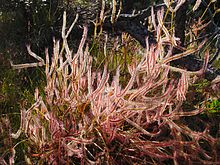
Drosera, which is commonly known as the sundews, is one of the largest genera of carnivorous plants, with at least 194 species. These members of the family Droseraceae lure, capture, and digest insects using stalked mucilaginous glands covering their leaf surfaces. The insects are used to supplement the poor mineral nutrition of the soil in which the plants grow. Various species, which vary greatly in size and form, are native to every continent except Antarctica.

Cephalotus is a genus which contains one species, Cephalotus follicularis the Albany pitcher plant, a small carnivorous pitcher plant. The pit-fall traps of the modified leaves have inspired the common names for this plant, which include 'Albany pitcher plant", "Western Australian pitcher plant", "Australian pitcher plant", or "fly-catcher plant." It is an evergreen herb that is endemic to peaty swamps in the southwestern corner of Western Australia.

Drosera spatulata, the spoon-leaved sundew, is a variable, rosette-forming sundew with spoon-shaped leaves. The specific epithet is Latin for "spatula shaped," a reference to the form of the leaves. This sundew has a large range and occurs naturally throughout Southeast Asia, southern China and Japan, Micronesia, Papua New Guinea, eastern Australia, Tasmania and New Zealand. Variants are often known by the localities in which they are found. The plant does not form hibernacula in winter, and is easily grown using the same methods as Drosera capensis.

Drosera regia, commonly known as the king sundew, is a carnivorous plant in the sundew genus Drosera that is endemic to a single valley in South Africa. The genus name Drosera comes from the Greek word droseros, meaning "dew-covered". The specific epithet regia is derived from the Latin for "royal", a reference to the "striking appearance" of the species. Individual leaves can reach 70 cm (28 in) in length. It has many unusual relict characteristics not found in most other Drosera species, including woody rhizomes, operculate pollen, and the lack of circinate vernation in scape growth. All of these factors, combined with molecular data from phylogenetic analysis, contribute to the evidence that D. regia possesses some of the most ancient characteristics within the genus. Some of these are shared with the related Venus flytrap (Dionaea muscipula), which suggests a close evolutionary relationship.
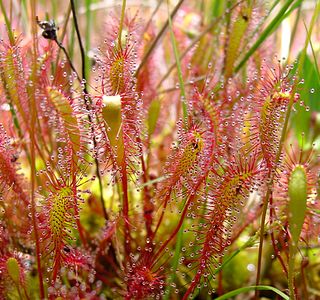
Drosera anglica, commonly known as the English sundew or great sundew, is a carnivorous flowering plant species belonging to the sundew family Droseraceae. It is a temperate species with a circumboreal range, although it does occur as far south as Japan, southern Europe, and the island of Kauai in Hawaii, where it grows as a tropical sundew. It is thought to originate from an amphidiploid hybrid of D. rotundifolia and D. linearis, meaning that a sterile hybrid between these two species doubled its chromosomes to produce fertile progeny which stabilized into the current D. anglica.
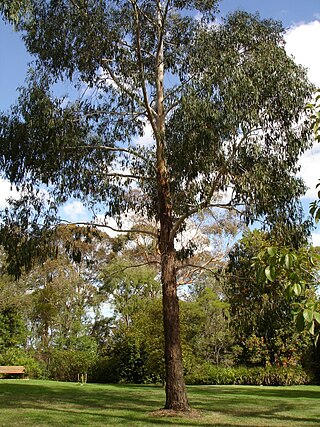
Eucalyptus ovata, commonly known as swamp gum or black gum, is a small to medium-sized tree species that is endemic to south-eastern Australia. It has mostly smooth bark, glossy green, lance-shaped to egg-shaped adult leaves, green flower buds in groups of seven, white flowers and conical to bell-shaped fruit.

Utricularia dichotoma, commonly known as fairy aprons, is a variable, perennial species of terrestrial bladderwort. It is a widespread species with mauve or purple fan-shaped flowers on a slender stalk and usually grows in wet locations.

Brachyscome ciliaris, commonly known as variable daisy, is a small bushy perennial herb with a prominent flower, which occurs throughout most of temperate Australia
There are fourteen species of carnivorous plants occurring in New Zealand, and four species that have been known to occur in the past.
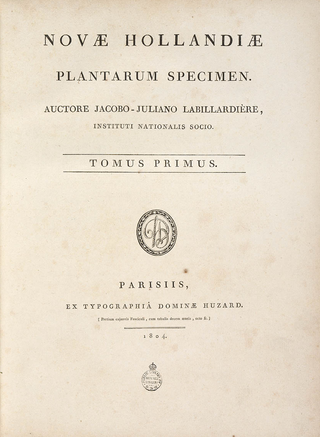
Novae Hollandiae Plantarum Specimen is a two-volume work describing the flora of Australia. Facsimiles of the originals can be found in the online Biodiversity Heritage Library (Vol.1) and Vol 2).
Relation du Voyage à la Recherche de la Pérouse is an 1800 book that gives an account of the 1791-1793 d'Entrecasteaux expedition to Australasia. The title refers to the search for La Pérouse, who disappeared in the region in 1788, a popular, though unsuccessful, object of the mission. Many of the discoveries made by the scientists attached to the expedition were published in the two volumes. The author, Jacques Labillardière, was a French botanist on the voyage, engaged to collect and describe the flora of the continent. The work includes some of the earliest descriptions of Australian flora and fauna, and an account of the indigenous peoples of Tasmania.
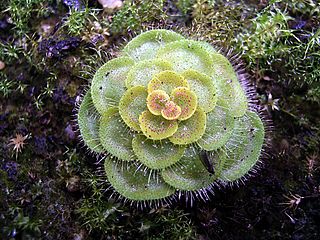
Drosera zonaria, the painted sundew, is a perennial tuberous species in the carnivorous plant genus Drosera and is endemic to south-west Western Australia from near Perth southeast to near Esperance. It grows in a tight rosette approximately 5 to 7 cm in diameter with 20 to 30 green to red leaves that are arranged in concentric layers. The leaves are typically 1 cm wide and are usually described as being "kidney-shaped" with crimson leaf margins. It grows in deep silica sands in open woodland or coastal heathland and only flowers after a bush fire, which is speculated to be caused by the release of ethylene. Its white, sweetly perfumed flowers, which are very similar to those of D. erythrorhiza, emerge on 4 to 5 cm tall scapes. As with most other tuberous Drosera species, D. zonaria will die back during the dry summer months and retreat to the fleshy tuber 10 to 30 cm below ground.

Drosera gigantea, the giant sundew, is an erect perennial tuberous species in the carnivorous plant genus Drosera that is endemic to Western Australia. It grows in sandy soils at the margins of swamps and near granite outcrops along the Western Australian coast from Albany north to just south of Geraldton. D. gigantea produces small shield-shaped leaves along many lateral branches that look like a small tree. Individual plants can grow up to 0.2–1 m (0.7–3.3 ft) tall. Because of its tall, tree-like form, it is considered one of the largest Drosera species. It is also easily cultivated and enjoys damp, humid conditions often provided in greenhouses. White flowers emerge from August to November. The red tubers of this species can grow to be 3.8 cm (1.5 in) in diameter and may be a metre below ground.

Drosera glanduligera, commonly known as the pimpernel sundew or scarlet sundew, is a species of carnivorous plant endemic to southern Australia. It is an ephemeral annual plant that grows in the winter and flowers from August to November.
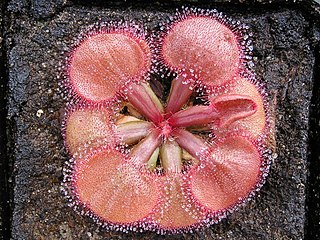
Drosera falconeri is a carnivorous plant in the family of Droseraceae. It is endemic to the Northern Territory of Australia.

Pultenaea juniperina, commonly known as prickly bush-pea or prickly beauty is a species of flowering plant in the family Fabaceae and is endemic to south-eastern Australia. It is an erect, spiky shrub with hairy stems, linear to narrow elliptic leaves with stipules at the base, and yellow-orange and red flowers.

Persoonia juniperina, commonly known as prickly geebung, is a species of flowering plant in the family Proteaceae and is endemic to south-eastern Australia. It is a small erect to low-lying shrub with smooth bark, hairy new branches, linear leaves, yellow flowers borne singly or in groups of up to forty in leaf axils, and yellowish green to purplish fruit.
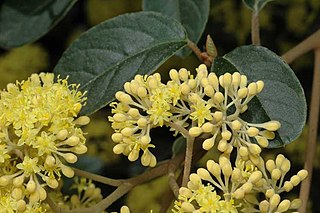
Pomaderris elliptica, commonly known as yellow dogwood or smooth pomaderris, is a species of flowering plant in the family Rhamnaceae and is endemic to south-eastern Australia. It is a shrub with densely hairy branchlets, egg-shaped or elliptic leaves, and pale yellow flowers.

Carnivorous Plants of Australia is a three-volume work on carnivorous plants by Allen Lowrie. The three tomes were published in 1987, 1989, and 1998, by University of Western Australia Press.

Hibbertia acicularis, commonly known as prickly guinea-flower, is a species of flowering plant in the family Dilleniaceae and is endemic to eastern Australia. It is an erect or prostrate shrub with linear to lance-shaped leaves and yellow flowers arranged singly in leaf axils with the six to eight stamens joined at the base, in a single cluster.
